 What is LoRaWAN?
What is LoRaWAN?
If you are looking for a common protocol for your smart assets and IoT devices to communicate with one another then LoRaWAN™ is a great choice. LoRaWAN™ is a long range (LoRa), wide area network (WAN) specification that is optimized to use very little power. This means LoRaWAN™ is perfect for wireless, battery powered end points in an IoT network, and can securely deliver two-way communications at data rates from 0.3 kbps to 50 kbps.
Ideal applications for LoRaWAN™ are sensor networks, security systems, smart home, smart metering, industrial control and smart cities. Amsterdam was the first city to crowdfund an Internet of Things Data Network using 10 gateways to give complete LoRaWAN™ coverage.
Ranges of 2-5km in an urban environment or up to 15km in a suburban environment are possible by trading off communication range and message duration over a spread spectrum of sub GHz frequencies and an adaptive data rate scheme. LoRaWAN™ operates in a star of star topology where gateways provide a transparent bridge sending and receiving messages between end point devices and a central network or cloud.
The gateways, typically powered devices, communicate via the LoRaWAN™ protocol with end points before relaying the messages on through more traditional protocols such as Ethernet, 3G or Wi-Fi. Most end point communication is bidirectional however LoRaWAN™ supports multicast broadcasts for node upgrades or mass distribution emergency messages.
This feature is especially useful in the Flood Network’s implementation of LoRaWAN™ with a network of sensors along an area susceptible to flooding to provide an early warning system to affected residents.
For LoRaWAN™ implementations managing critical national infrastructure data or personal data the specification includes several layers of encryption.
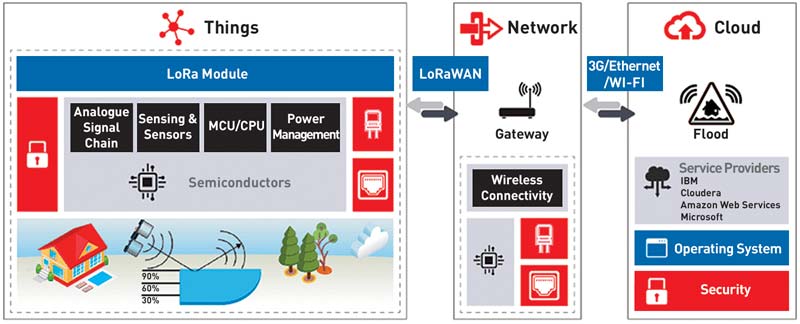 • Unique Network key (EUI64)
• Unique Network key (EUI64)
• Unique Application key (EUI64)
• Device specific key (EUI128)
Depending on your application end devices can have different classes of functionality.
• Class A – The lowest power end-device class, where devices can transmit (uplink) whenever they like, but receive (downlink) windows are only allocated following transmit.
• Class B – The network provides a beacon signal that devices use to open receive windows at scheduled times, and in between which they can transmit.
• Class C – The most power hungry mode of operation, Class C devices are able to continuous receive unless they are transmitting.
LoRaWAN big advantages are:
• It is long range – each gateway has a theoretical range of 15km. In built up areas 1-2km is more realistic.
• It is low-powered – devices can be battery operated, and batteries can last several years for devices that are sending data a few times a day, for example a parking sensor in a car park, or a sensor that measures water levels and provides early warning of floods.
• It is low cost – LoraWAN gateways can be bought for around £400 or made for £200. This means an area like Reading can be covered for just a few thousand pounds. LoraWAN operates in the 868MHz frequency, so there are no license fees and no need to pay telecoms companies for sending and receiving data.
Microchip RN171-I/RM 3 → 3.7V WiFi Module, IEEE 802.11 GPIO, SPI, UART
RS Stock # 765-2881
Mfr. Part # RN171-I/RM
The Microchip RN171 is a compact 802.11b/g WiFi Module that simplifies adding WiFi connectivity into designs.The module integrates all the required hardware with an on-board TCP/IP stack to provide a full featured 802.11b/g module. Configuration of the RN171 is via simple ASCII commands over UART.The Power Management features of the RN171 are ideal for portable, battery powered applications. The module features Battery Boost Circuitry and in Sleep Mode consumes only 4 μA.
 Device Features
Device Features
• Complete, Embedded 2.4 GHz IEEE 802.11b/g Wireless LAN Module
• 14 GPIO Pins (Four GPIOs shared with UART)
• Eight Analogue Sensor Inputs
• Compact Form Factor: 26.67 × 17.78 × 3.18 mm
• Integrated Crystal, Internal Voltage Regulator, Matching Circuitry, Power Amplifier
• Configured using Simple ASCII Commands
• Supports Infrastructure and SoftAp Networking Modes
• Built-in Networking Applications: TCP, UDP, DHCP, DNS, ICMP, ARP, HTTP Client, and FTP Client
• Complete On-Board TCP/IP Networking Stack
• Unique MAC Address
• Upgrade Firmware Over the Air using FTP
• Supports WiFi Protected Setup (WPS)
• Security: WEP-128, WPA-PSK (TKIP), WPA2-PSK (AES)
RF Features
• Frequency: 2.412 to 2.462 GHz
• 802.11b Modulation Compatibility: DSSS (CCK-11, CCK-5.5, DQPSK-2, DBPSK-1)
• 802.11g Modulation Compatibility: OFDM
• Receive (Rx) Sensitivity: -83 dBm (typical)
• Power Output: 0 to +12 dBm
Power Management Features
• Ultra Low-Power Sleep Mode (4 μA)
• Battery Boost Control Circuitry
• Real-Time Clock for Time Stamping, Auto-Sleep, and Auto-Wake WLAN (Wireless Local Area Network) – Microchip Technology
RF Solutions RF-LORA-868-SO RF Transceiver Module 868 MHz, 1.8 → 3.6V
RS Stock # 903-3059
Mfr. Part # RF-LORA-868-SO
The LoRa™ RF Transceiver Module features the Semtech SX1272 transceiver chip which uses a variation of Chirp Spread Spectrum coding called LoRa, to improve receiver sensitivity and hence achieve extended range. The module can also use OOK and FSK modulation schemes to maintain compatibility with other standards such as IEEE 802.15.4 and wMBUS. LoRa features increased interference immunity over conventional FSK providing an enhanced coexistence capability in crowded channels.
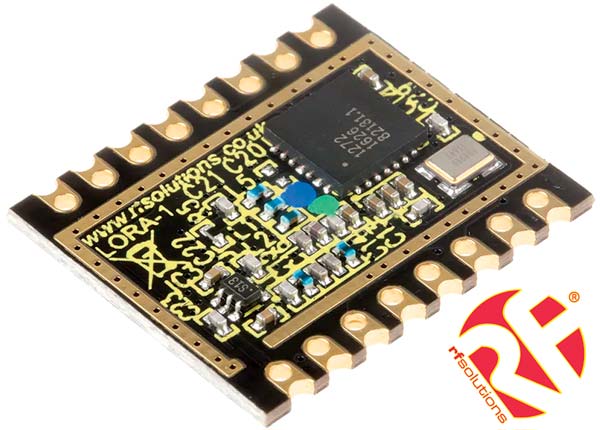 Features
Features
• RF Frequency Range: 868MHz ISM Band
• Channel bandwidth: 125kHz, 250kHz or 500kHz
• RF Power Output: up to +20dBm
• +14 dBm high efficiency PA
• Receiver Sensitivity: -119dBm @ 1.2kbps (FSK), -137dBm @ 240bps (LoRa, SF=12, CR=4/8)
• Modulation: FSK, GFSK, MSK, GMSK or OOK
• LoRa™ spread-spectrum technology
• OTA Data Rate: up to 250kbps (FSK/OOK), up to 37.5kbps (LoRa)
• Range: up to 16km (Line of Sight)
• Packet engine up to 256 bytes with CRC
• Forward Error Correction (FEC) with selectable Coding Rate
• 127dB dynamic range RSSI
• Host communication: serial SPI
• Temperature sensor and low-battery indicator
• Power supply: +2.2V to +3.7Vdc
• Operating temperature range: 0 to +55°C
• Dimensions: 23 × 20 × 1.5mm
• Applications: Meter reading, sensor networks, wireless alarms, home automation, long-range communication for the Internet of Things (IoT)
• External 50Ω antenna required.
Microchip PICTail Plus LoRa Daughter Board – RN-2483-PICTAIL
RS Stock # 904-8468
Mfr. Part # RN-2483-PICTAIL
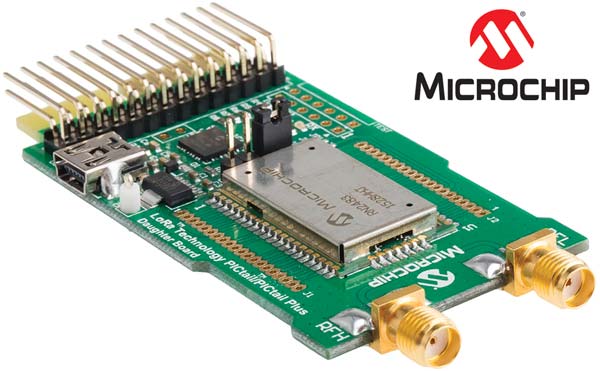 Microchip’s RN-2483-PICtail is a development board featuring the RN2483 LoRa® 433/868 MHz LoRa Module. The board gives users access to all the RN2483 Module’s UART and GPIO ports.
Microchip’s RN-2483-PICtail is a development board featuring the RN2483 LoRa® 433/868 MHz LoRa Module. The board gives users access to all the RN2483 Module’s UART and GPIO ports.
The PICtail/PICtail Plus connector allows the RN2483 to be developed with Microchip MCU development tools such as the Explorer 16 (DM240001) and Explorer 8 (DM160228), adding LoRa technology to these platforms.
Features
• Microchip RN2483 Low-Power Long Range, LoRa® Technology Transceiver Module
• SMA connectors for 433 MHz and 868 MHz bands
• PIC18 MCU with In-Circuit Serial Programming (ICSP) header for custom functions
• Solder pads around the module for GPIOs, power pins and communication signals
• Supply Current measurement points
• On-board LDO
• UART traffic LEDs
• USB connector
• PICtail /PICtail Plus connection interface
DraginoLoRa/GPS_HAT GPS, LoRa HAT for MT3339, SX1276/SX1278
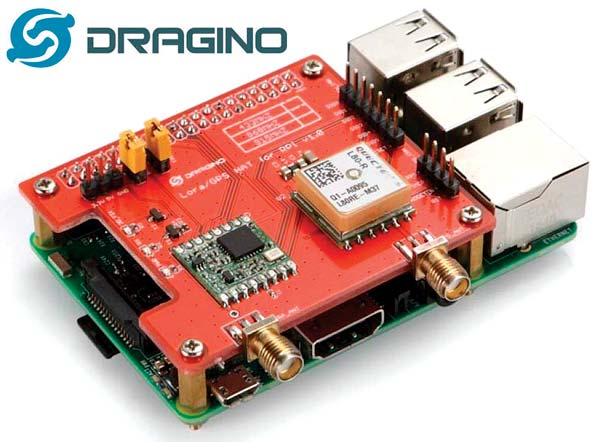 RS Stock # 187-5121
RS Stock # 187-5121
Mfr. Part # Lora /GPS HAT 920: 920 Frequency
LoRa Shield is a long range transceiver on a Arduino shield form factor and based on Open source library.The Shield allows the user to send data and reach extremely long ranges at low data-rates.It provides ultra-long range spread spectrum communication and high interference immunity whilst minimising current consumption.
LoRa Shield is based on Semtech SX1276/ SX1278 chip, it targets professional wireless sensor network applications such as irrigation systems, smart metering, smart cities, smartphone detection, building automation, and so on.
Using Hope RF’s patented LoRaTM modulation technique the Dragino Shield featuring LoRa® technology can achieve a sensitivity of over -148dBm using a low cost crystal and bill of materials. The high sensitivity combined with the integrated +20 dBm power amplifier yields industry leading link budget making it optimal for any application requiring range or robustness. LoRaTM also provides significant advantages in both blocking and selectivity over conventional modulation techniques, solving the traditional design compromise between range, interference immunity and energy consumption.
These devices also support high performance (G)FSK modes for systems including WMBus, IEEE802.15.4g. The Dragino Shield featuring LoRa® technology deliver exceptional phase noise, selectivity, receiver linearity and IIP3 for significantly lower current consumption than competing devices.
SemtechLoRa Module for SX1276 – SX1276MB1MAS
RS Stock # 922-5889
Mfr. Part # SX1276MB1MAS
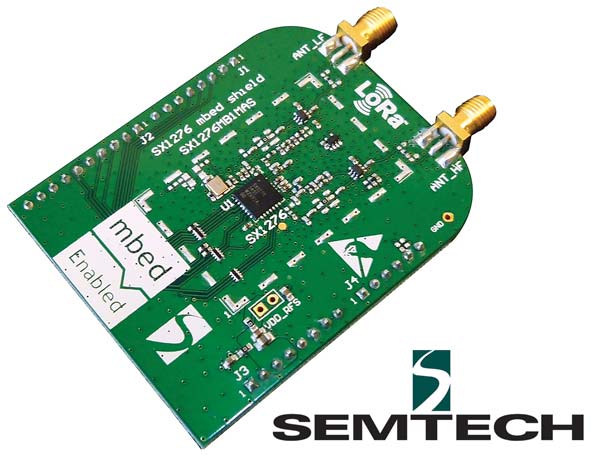 The SX1276MB1MAS is a low-power 433/868MHz dual-band transceiver Shield-format evaluation module from Semtech featuring their long-range LoRa™ technology.
The SX1276MB1MAS is a low-power 433/868MHz dual-band transceiver Shield-format evaluation module from Semtech featuring their long-range LoRa™ technology.
The on-board SX1276 transceiver device offers wide area communication with extreme tolerance of interference. LoRa technology is ideal for Internet of Things (IoT) applications, enabling connection to LoRaWAN™ gateways. Example applications include sensor circuits and wireless battery-powered devices.
Features
• SX1276 dual-band RF transceiver set up with operating frequencies of 433 and 868MHz
• LoRa™ Chirp Spread-Spectrum technology
• PE4259 RF antenna switches
• Controlled via serial SPI bus @10Mbps
• UART and I²C serial busses available for sensor connections
• mbed compatible headers
• Split Rx/Tx architecture for optimum performance
• 2 × SMA antenna connectors
Author: Bogdan Grămescu


